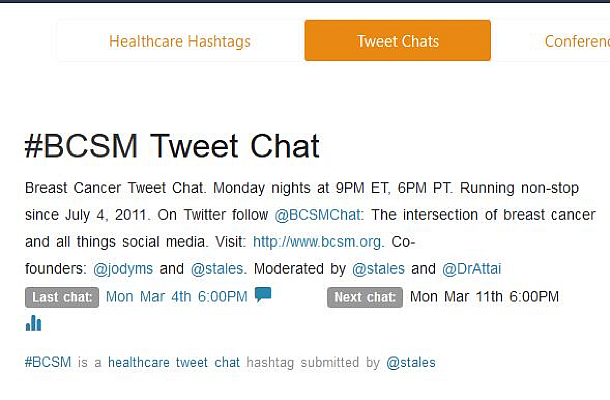How to use Twitter to find a treasure trove of real patient voices

Thousands of patients spend time on Twitter talking about their cancer, or diabetes, or psoriasis, or almost any diagnosis you can imagine. As a reporter, you can find patients to interview while absorbing valuable background here. You can find an individual to be the face of your story, or sharpen your perspective on a chronic disease by reading about the experiences of dozens of patients living with it. These insights can change the questions you ask and the direction of your reporting.
Where patients linger
Think of a middle school cafeteria at lunch. Students clump together by interest. One table is people who play Fortnite, another is theater folks, and another is football players. The same thing happens on Twitter. Dozens of weekly live chats happen around health. Many are organized by a diagnosis, such as breast cancer. If you know the right hashtag, you can find knowledgeable patient leaders and followers talking about newsworthy topics. To extend the metaphor, you can sit down at the table with a crowd of people talking about your story topic. One of the most well-known of these tags is #bcsm, which stands for breast cancer social media.
Begin your search at the Healthcare Hashtag Project at a website called Symplur. Symplur is a for-profit company that sells information about social media analytics, but maintains some free data, including the hashtag project.
Search for a disease to see the tags related to it. Once you settle on one, you will see individual “names” or Twitter handles, sorted mathematically to show the most influential first.
In many cases, live chats have leaders who set the agenda and moderate as people comment. These leaders are often people who have been dedicated to advocacy in a specific disease for a decade or more. One of the leaders of the #bcsm chat is patient Alicia Staley, for example.

On Symplur, you can also download a free transcript of chats from a designated time period.
Because Twitter posts are public, a reporter may “quote” someone’s tweets. Publications handle this in different ways. Sometimes the tweet is embedded into your story and appears just as it does on the platform. Other times you can excerpt a quote just as if you had overheard it. Your editors or publication will have a style guideline for this.
Ways to start a dialogue
Social media platforms inspire people to be strangely intimate with details of illness. I’ve read things exchanged by patients that I would hesitate to quote. For example, comments might cover sexual health, or the response of partners and children to grief. As a check, you can repeat something back to that person and ask: “Can I use this in a story I’m writing?”
Here are a few ways to contact people on Twitter if you don’t have their emails: 1) Write a direct message or DM to them. Some people have their account configured so DM is open. Others don’t accept DMs unless they come from someone they follow. 2) Reply to their post by posting, “I’m Nancy Smith from X Magazine, and could I talk to you about this comment? Write me at info[at]magazine.com, please.” 3) Post openly that you’re reporting about a topic and invite anyone to write you at a specific email, or by DMs directly on Twitter. Be sure to include the relevant hashtags in your tweet to reach your target audiences. 4) Patients might have contact information in their bio on Twitter, so their email might be discoverable.
If you fear that patients talking with each other are always whining and possibly sharing less-than-credible medical advice, know that #bcsm chats frequently include very astute patients and physicians and researchers too. One #bcsm moderator is Dr. Deanna Attai, a UCLA surgeon and past president of the American Society of Breast Surgeons. I’ve seen chats where detailed clinical research protocols are discussed, digested, and risks and benefits debated.
Keep in mind that patients can have conflicts of interest, just like physicians and institutions can. Ask a patient if they receive any financial support from pharmaceutical companies, for example. Some might accept travel grant money to attend research conferences, and this might not make them less credible in your interview, but it is important to know and report. A 2018 report by Kaiser Health News detailed how patient advocacy groups, not individual patients, received millions from the drug industry.
Reporters should treat patient sources just as they do others — trying to verify that the person knows their territory. You can investigate the expertise of patient sources in several ways. Find examples of what the patient says about him or herself at any blog or bio that is posted. Find evidence that a patient has spoken in public before for credible organizations. If you are quoting the patient to tell you how it feels to have rheumatoid arthritis, of course, they are credible on their own experience. But if you are quoting them criticizing diagnosis or financial issues, you may want to hold them to a different standard.
Patient conversations open a window to the everyday lives of people with chronic conditions, and can improve your reporting by grounding your stories in the struggles of real people. For myself, this window opened most dramatically in 2015. I was online watching while thousands of patients and doctors commented live during the broadcast of the PBS series “Cancer, The Emperor of All Maladies.” Some cried, some posted that they had to stop watching because of painful memories, and others found this historical look at cancer research inspiring. I used those tweets to write about that experience for the Public Library of Science.

